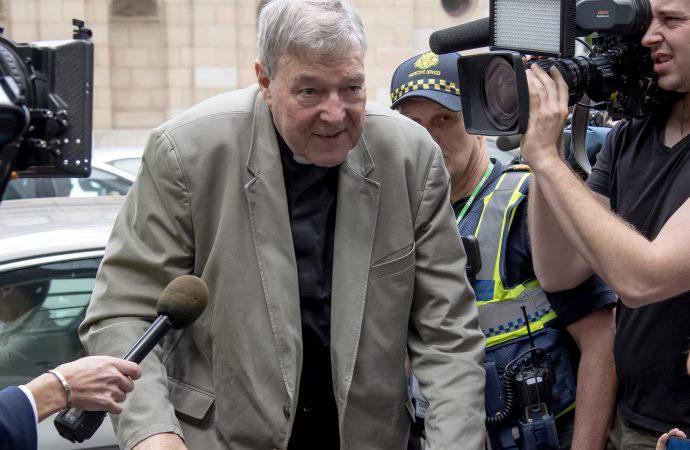Although Australian Cardinal George Pell’s appeal of a conviction on child sexual abuse charges was rejected Wednesday, that ruling may not be the end of legal road. As of this writing, Pell’s attorneys were still weighing whether to file a final appeal to Australia’s High Court.
Those attorneys told reporters that Pell continues to maintain his innocence, as he has since the charges first became public in June 2017.
Though Pell’s judicial odyssey may not be over, Wednesday’s ruling likely does represent the final word on another aspect of the case: George Pell is now officially the Alfred Dreyfus of the Catholic abuse crisis, meaning that opinions about his guilt or innocence are at least as much a reflection of one’s ideological convictions as about the actual evidence in the case.
Dreyfus, of course, was the French artillery officer of Jewish descent charged with treason in 1894 for allegedly passing military secrets to the Germans, spending five years on Devil’s Island. Dreyfus was eventually acquitted and reinstated to his army position, but for more than a decade, opinions about his guilt or innocence functioned as a bellwether for broader political and cultural tensions, pitting Catholic and traditionalist “anti-Dreyfusards” against pro-Republican and anti-clerical liberals.
One could, by the way, just as easily compare Pell to Alger Hiss, the urbane American diplomat accused in 1948 of being a Soviet spy. Like Pell, Hiss was tried twice, with the first ending in a hung jury and the second resulting in a conviction. In that case, too, opinions for a long time were far more about the clash between hawks and doves during the Cold War than the facts.
Similarly, opinions about Pell today often reveal far more about the prejudices of the observer than about the actual reality of what happened.
Those most outraged by the clerical abuse crisis, generally convinced that the Church is corrupt and eager to see senior officials such as Pell held accountable, have assumed Pell’s guilt from the beginning and are celebrating Wednesday’s outcome.
“Today’s decision by the Victoria Court of Appeal is a watershed event, a sign of progress that should give all victims hope,” said Anne Barrett Doyle of the activist group BishopAccountability.org.
Pope Francis, Barrett Doyle said, “should move swiftly now to condemn and penalize Pell, removing him from the College of Cardinals and laicizing him.”
Yet there’s a sizeable share of Catholic opinion, which isn’t restricted to the Vatican or the Australian bishops but which has a significant footprint at the grassroots all around the world, which has been equally convinced from the beginning that Pell is innocent, and which will remain so today.
This group believes that the evidence in Pell’s case is basically incredible. They find the idea that an archbishop during a high Sunday Mass in his own cathedral could break away alone from a procession, enter a highly trafficked sacristy and abuse two young choir members without being seen by anyone and despite wearing liturgical vestments that would render the physical acts involved almost impossible, then reemerge and greet worshippers outside as if nothing had happened, so unbelievable as to be almost surreal.
For that group, the fact that Pell was ever charged, let alone tried and convicted, speaks far more to a lynch-mob attitude in Australia than it does about the credibility of the accusation.
Recently, an Australian artist painted a mural of Pell in handcuffs with Satan behind him on an overpass on a busy Roman street near the Vatican. As it happens, the mural was located right across the street from the parish I sometimes attend for Sunday Mass, so I asked one of the priests there what he made of it.
“It’s disgusting,” this Italian Franciscan told me. “It’s unbelievable that the Australian system of justice let things get this far … these charges couldn’t even be brought to trial anywhere else, because they’re just ridiculous.”
This priest, by the way, has no Vatican gig and has never met George Pell. He’s simply a parish priest who knows how things work in a busy cathedral church on a Sunday, for whom these allegations don’t pass the smell test.
It’s hard to know what new development, or new bit of evidence, might bridge that gulf. From here on out, George Pell is likely to be a symbol of clerical arrogance and culpability to some, and a cautionary tale about hysteria and false allegations to others.
As for Pell’s fate with the Church, odds are that no final decision will be reached about taking away Pell’s red hat or expelling him from the priesthood until we know if he plans a further appeal to the Supreme Court. That, by the way, is what distinguishes Pell’s case from that of ex-cardinal and ex-priest Theodore McCarrick, since few Catholics voiced much doubt about the veracity of the reports of McCarrick’s misconduct.
Wednesday morning, Vatican spokesman Matteo Bruni repeated the Holy See’s respect for the Australian justice system while adding that Pell “has always maintained his innocence throughout the judicial process and it is his right to appeal to the High Court.”
What the statement didn’t say, but it’s very much part of the subtext, is that there are important people on the pope’s team who may have little use for George Pell politically or personally, but they don’t believe he’s guilty of these charges either.

